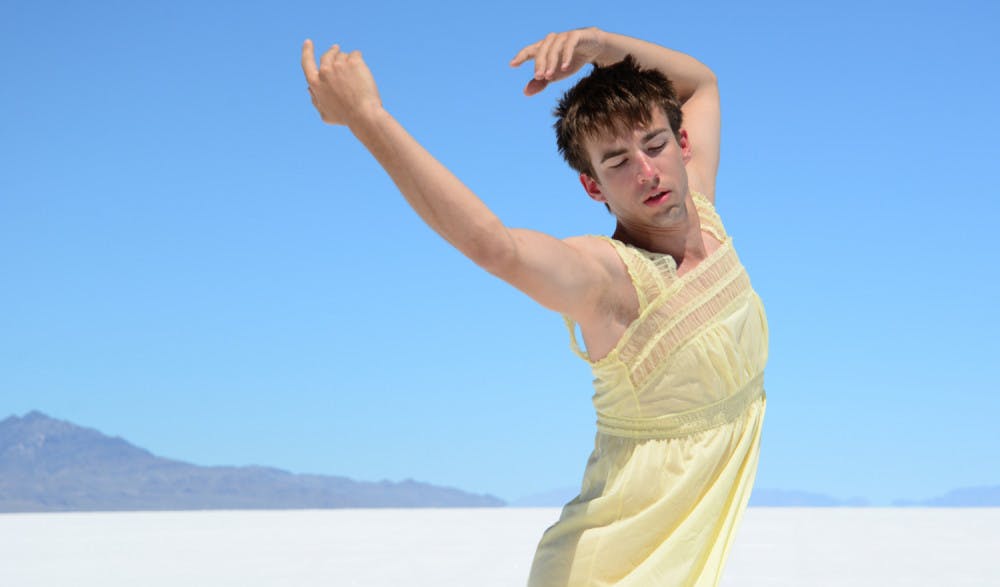In the intimate setting of the Middlebury College Dance Theatre, artist-in-residence Scotty Hardwig and guest performer Keanu Forrest Brady, accompanied by media operator Michael Ryba, explored masculinity in the digital frame.
The six works presented, including two short film installations, came together the evening of Saturday, Oct. 18 from several years of works, but Hardwig said he saw common themes underlying them all.
“I realized that I’ve been making work about the same thing,” he said. “My work is always somehow about gender.”
The pieces flowed together as entrances and exits, and beginnings and endings all felt part of the performance, perhaps hinting at the performative nature of gender and masculinity.
As the audience filtered in before the show began, the seats in the darkened theater ringed the rectangle of gridded light. When Brady entered to lie down shrouded under the projection, it was as if he had entered a digital frame which he never left over the course of the piece. As the grid-patterned light began to move, the projection on Brady’s skin fooled the eye into believing that Brady’s body was moving, an illusion only broken by his actual movement a few moments later. As Brady was wearing only a revealing dance belt, the audience was able to fully experience the sensation of hearing his skin contacting the floor as he stretched and glided all around the projection frame, always close to the ground. At times swallowing Brady with blackness, the dimensionality of the projection evoked a feeling of dynamism between dancer and environment. The relationship between dancers and set can often be biased toward a focus on the dancers’ movement, but here the human motion was equally important to the projection’s motion. When Brady finally rose to his feet, the digital net-like lighting that he had been swimming through disappeared, and strobe lighting teased the eye with single-frame glimpses of fluid movement.
Hardwig continued this exploration of dancer and environment in Quiet Blossoms Sometimes Burning, an improvisational work-in-progress in Ryba’s manipulation of the light projection and Hardwig’s movement formed a digital duet. In contrast to Brady’s prominent and audible contact with the floor surface, Hardwig was light-footed and made little sound in his contact with the white marbley performance surface. The interactive quality of the piece was emphasized by the colorful sparks of the projection on the floor. At moments sparks flew on the floor as Hardwig sustained slower, fluid motion, creating the thrilling feeling that Hardwig was a still figure in a whirlwind of passing motion.
Dornwald, the first of two short film installations, changed the three-dimensional dancer and environment relationship into two dimensions as the film was projected onto the floor. Though it was difficult to see the whole picture from the angle of seating, Dornwald’s negative coloration and overlay of multiple video images gave an eerie and almost frightful mood to the room, enhanced by the sound of the Vienna Boy’s Choir recording of “Kyrie Eleison.”
When a human presence returned to the stage there was an air of near relief. A physical body is easier for this writer to relate to than two-dimensional negative colored images. Brady didn’t allow for much reassurance, however, in Of Dead Boys and Blind Men as his juxtaposition of seizure-like vibratory motion and sustained fluidity raised questions of perceived images of strength versus inner state. The choreography, a collaboration of Hardwig and Laquimah Vandunk’s, was dramatically embodied by the dexterity and mobile strength of Brady. An image that was met with audible appreciative reactions from the audience was a moment when Brady, kneeling and sitting on his heels, rose straight up to standing as if lifted from above, before continuing to flow within his frame.
In the second film installation, One Small Creature Crying in a Forest, dark colors framed a study of frenzied motion of the hands and feet, accompanied by the intimate sounds of breath and hands on skin.
The last piece brought Brady and Hardwig together on stage in coordinating slacks and button down shirts. After moving in unison at first, the duo created their most visually and physically spectacular moments of alternated lifts when Brady and Hardwig threw themselves at each other with full strength, only to be caught and have their energy transformed into a gentle revolving lift. These exchanges highlighted the central performance theme of male vulnerability in a world where it is often perceived as weakness, and therefore concealed.
In a brief discussion with the artists after vigorous applause, Hardwig spoke of his exploration of the masculine.
“Traditionally in dance, especially in ballet, the male dancer serves as a frame for the feminine,” he said. He expressed his aim to study masculinity in dance especially in a society that is often strongly opinionated about the image of male dancers, and queer male dancers in particular. Hardwig explained the approach to his creative process, which involves a complex, multidisciplinary incorporation of sound, videography, choreography and performance.
“It’s okay to get lost,” he laughed. “Some of the most meaningful discoveries come from that state of confusion.”
Hardwig said that he approaches a work with questions in mind to explore, but that art is not about finding concrete answers.
“I never feel like I’ve reached a conclusion at the end of a piece,” he said. “But therein lies the challenge and the delight of art making: it’s about exploration and discovery, but it never ends.”
Hardwig Explores Masculinity

Comments



